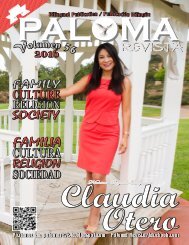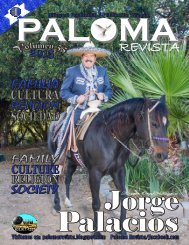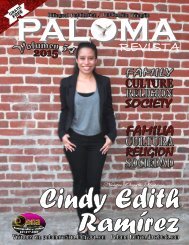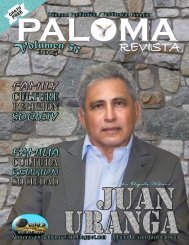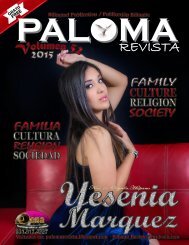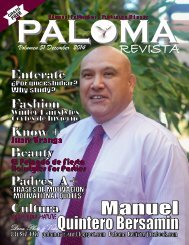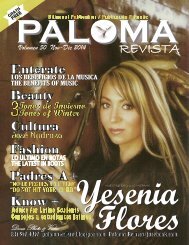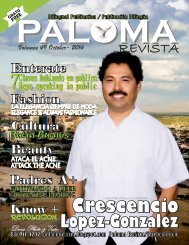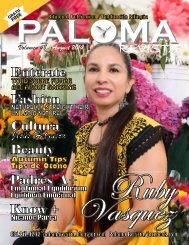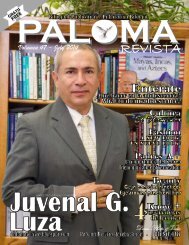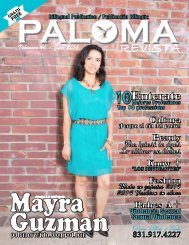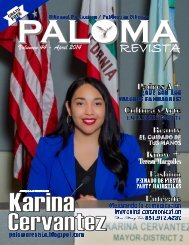Paloma Magazine Volume 43
Paloma is a nonprofit Magazine for the entire family. We intend to educate and inform the community with positive messages and themes. We are also a media communication that offers publicity to the community. In Paloma Magazine by advertising your business, you get more than advertising because this magazine brings valuable and useful information with a positive message to households. In every issue we bring together and promote, culture, family, religion.
Paloma is a nonprofit Magazine for the entire family. We intend to educate and inform the community with positive messages and themes. We are also a media communication that offers publicity to the community. In Paloma Magazine by advertising your business, you get more than advertising because this magazine brings valuable and useful information with a positive message to households. In every issue we bring together and promote, culture, family, religion.
Create successful ePaper yourself
Turn your PDF publications into a flip-book with our unique Google optimized e-Paper software.
Centro Nacional<br />
Steinbeck<br />
Construyendo comunidad, celebrando la creatividad inspirada<br />
en las palabras de John Steinbeck.<br />
Contribuido por Berniz House<br />
Arts Council for Monterey County<br />
El Centro Nacional Steinbeck está situado en la ciudad natal de John<br />
Steinbeck en Salinas, California. A unas 17 millas de Monterey, se<br />
encuentra en el corazón de Steinbeck Country. El centro ofrece<br />
diferentes experiencias a los visitantes, ya sea en literatura e<br />
historia, agricultura y el arte, así como eventos especiales y programas<br />
educativos. En la Sala de exposiciones John Steinbeck, la literatura<br />
sobresalta de las paredes y se va directamente a la imaginación del<br />
visitante. Descubra el mundo de Steinbeck a través de exhibiciones<br />
interactivas y multi-sensoriales para todas las edades; vea artefactos<br />
raros en siete salas temáticas que muestran artículos de los libros<br />
Este del Edén, Cannery Row, De ratones y hombres, Las uvas de la ira<br />
y mucho más. Disfrute la sala de arte y exposiciones culturales en los<br />
múltiples espacios de la galería.<br />
Oriundo de la tierra y el pueblo del Valle de Salinas, Steinbeck logró el<br />
reconocimiento mundial por sus agudas observaciones y poderosas<br />
descripciones de la condición humana. Defendió a los olvidados y<br />
marginados, mientras que afirmaba la fuerza del espíritu humano. Su<br />
vida era rica y provocadora como el valle de Salinas que él inmortalizó<br />
en sus escritos. Steinbeck se inspiró en esta tierra y se hizo conocido<br />
en todo el mundo, recibiendo el Premio Nobel de Literatura en 1962.<br />
El Centro es una atracción maravillosa para grupos escolares, visitas<br />
guiadas para adultos y un lugar único para eventos especiales.<br />
Los fondos recaudados a través de las admisiones, membresías,<br />
programas, tienda de museo de ventas, eventos y donaciones ayudan<br />
a apoyar el Centro, que es una institución sin fines de lucro.<br />
El Centro Nacional Steinbeck ofrece varios eventos gratuitos para la<br />
comunidad de Monterey County. Así como también ofrece eventos<br />
libres para al público. Es parte de las celebraciones del Primer viernes<br />
del mes o “First Fridays”, Celebración del Nacimiento de John<br />
Steinbeck, y festivales como el Día de los muertos, Días feriados<br />
navideños, entre otros. Así que ya sabe, traiga a su familia y conozca<br />
más de la historia detrás de este mito real.<br />
Para más información sobre eventos por venir visite:<br />
www.steinbeck.org<br />
Facebook: “Consejo de Arte del Condado de Monterey”<br />
www.culturalmonterey.com<br />
Quién fue John Steinbeck?<br />
John Steinbeck nació en Salinas, California el año 1902.<br />
Ganador del Premio Pulitzer in 1940, y el Premio Nobel<br />
de la Literatura en 1962.<br />
Fue graduado en la Salinas High School, estudió de<br />
forma intermitente Biología Marina en la Universidad<br />
de Stanford, sin llegar a titularse, ya que marchó a<br />
Nueva York para abrirse camino como escritor. Allí<br />
realizó varios trabajos, incluso en prensa, pero sin éxito, regresando<br />
a California en donde de nuevo se tuvo que ganar la vida. En 1928,<br />
decidió dedicarse de lleno a la escritura, publicando un año después,<br />
con escaso éxito, que alcanzaría con sus siguientes novelas. Vivió en<br />
varios lugares y durante la Segunda Guerra Mundial, fue corresponsal<br />
de guerra en Europa para el diario “The New York Herald Tribune”.<br />
Las novelas de Steinbeck son consideradas de realismo social que<br />
tratan sobre la mano de obra rural y los problemas económicos que<br />
acompañan a estos trabajos. Pero también a la vez se nota en sus<br />
libros su adoración a la tierra, que no siempre están de acuerdo con<br />
su estilo prosaico de enfoque, sociológico. Después del humor áspero<br />
y terroso del libro Tortilla Flat (1935), se trasladó a temas más serios<br />
de ficción, a menudo muy agresivo en su crítica social. Por ejemplo,<br />
el libro En lucha incierta (1936) trata sobre las huelgas de los<br />
recolectores migrantes de fruta en las plantaciones de California.<br />
Varias de sus novelas han sido llevadas al cine. Sus obras más conocidas<br />
son “Las uvas de la ira, “La perla”, “De ratones y hombres” y “Al este del<br />
Edén”. Steinbeck continuó su vida literaria acompañado por el éxito<br />
hasta que falleció en 1962.<br />
National Steinbeck Center<br />
Building community, celebrating the creativity inspired by the words of John Steinbeck.<br />
Contributed by Berniz House /Council for Monterey County<br />
The National Steinbeck Center is located in the hometown of John Steinbeck in Salinas,<br />
California. At about 17 miles of Monterey, located in the heart of Steinbeck Country. The<br />
center offers visitors different experiences, whether in literature and history, agriculture<br />
and art, and special events and educational programs. In the John Steinbeck Exhibition<br />
Hall, literature startles the walls and goes directly to the visitor's imagination. Discover<br />
the world of Steinbeck through interactive and multi- sensory exhibits for all ages; see<br />
rare artifacts in seven themed rooms showing items of this books of Eden, Cannery Row,<br />
Of Mice and Men, The Grapes of Wrath and much more. Enjoy the living art and cultural<br />
exhibitions in multiple gallery spaces. Hailing from the land and the people of the Salinas<br />
Valley, Steinbeck achieved worldwide recognition for his acute observations and powerful<br />
descriptions of the human condition. He defended the forgotten and marginalized, while<br />
it affirmed the strength of the human spirit. His life was rich and provocative as the<br />
Salinas Valley that he immortalized in his writings. Steinbeck was inspired by the land and<br />
became known worldwide, receiving the Nobel Prize for Literature in 1962. The Center is<br />
a wonderful attraction for school groups, guided tours, and a unique venue for special<br />
events visitors. Funds raised through admissions, memberships, programs, museum shop<br />
sales, events and donations help support the Center, a nonprofit institution. The National<br />
Steinbeck Center offers several free events for the community of Monterey County. And<br />
also offers free events for the public. It is part of the celebrations of the First Friday of the<br />
month or "First Fridays", Celebration of the Birth of John Steinbeck, and festivals such<br />
as Day of the Dead, Days of Christmas holidays, among others. So you know , bring your<br />
family and learn more about the story behind this royal myth.<br />
Who was John Steinbeck? John Steinbeck was born in Salinas, California<br />
in 1902. Winner of the Pulitzer Prize in 1940 and the Nobel Prize for Literature in 1962.<br />
He was graduated from Salinas High School, he studied intermittently Marine Biology at<br />
the University of Stanford, short of graduating, as he went to New York to make it as a<br />
writer. There had various jobs, including press, but without success, returning to<br />
California, where he again had to make a living. In 1928, he decided to devote himself to<br />
writing, publishing a year later, with little success, to reach his subsequent novels.<br />
He lived in various places and during the Second World War, was a war correspondent in<br />
Europe for the newspaper "The New York Herald Tribune."Steinbeck 's novels are<br />
considered social realism that address the rural workforce and economic problems<br />
associated with these jobs. But while it shows in his books his worship the earth, which<br />
are not always in agreement with his prosaic style sociological approach. After the rough<br />
and earthy humor book Tortilla Flat ( 1935 ), he moved to more serious themes of fiction ,<br />
often aggressive in its social criticism. For example, the book In Dubious Battle (1936 )<br />
deals with the strikes of migrant fruit pickers on California plantations .Several of his<br />
novels have been made into films . His best known works are " The Grapes of Wrath ", "<br />
The Pearl ", " Of Mice and Men " and " East of Eden " .Steinbeck continued his<br />
literary life accompanied by success until his death in 1962.<br />
Predica con el ejemplo y si es necesario habla<br />
Lead by example and if necessary speak -San Francisco de Asís<br />
18 PALOMA REVISTA (831) 917- 4227 “AHORA...TODOS PUEDEN ANUNCIARSE’




